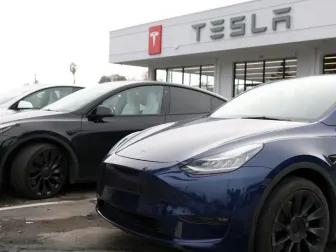January 29, 2025

Tesla posted a rare earnings miss for the last quarter of 2024, coupled with disappointing results amid weak sales and revenue leading to thinning profit margins.
Shares of Tesla ( TSLA ), which had gotten a lift since the election on hopes that the company would benefit from the close ties between CEO Elon Musk and President Donald Trump, initially fell 6% in after-hours trading before rebounding to a narrow gain.
The earnings miss comes as the company is facing headwinds from increased competition from electric vehicle offerings from other automakers in the United States, China and Europe, which has helped to squeeze the prices it can charge.
Tesla had already disclosed it had the first annual drop in sales in its history in 2024, but the company’s quarterly revenue of $25.7 billion was about $1.5 billion less than expected. Its net income of $2.5 billion was also a bit below forecasts, even though it was up 3% from a year earlier. But its profit margin of 13.6%, excluding the sale of regulatory credits was much tighter than recent years. Analysts had forecast a 16.2% margin.
The company did say that its plans for more affordable models “remain on track for start of production in the first half of 2025.” And it said its plans for the rollout of its Cybercab model of driverless robotaxi should be available in 2026. The company has often missed production targets for new vehicles in the past. But those promises, in the notes deep in the earnings report, apparently helped to lift shares off their post-market low immediately after the report’s release when investors were first looking at the topline numbers.
The company did not release any target for sales in 2025, although it did say it expects to return to sales growth once again. But the company went on to say that new growth would depend upon the “rate of acceleration of our autonomy efforts, production ramp at our factories and the broader macroeconomic environment.”
Musk has long had a wide range of activities apart from Tesla, as he is the CEO of SpaceX, the primary owner of social media platform X, as well as neurotechnology company Neuralink, tunneling outfit The Boring Company, and more recently an artificial intelligence company called xAi. But in recent months he’s been even more active in the efforts of the Trump administration, spending significant time with Trump and being in charge of the Department of Government Efficiency, or DOGE initiative.
He’s also become active in some politics of some European countries, backing far-right political parties in Germany and the United Kingdom. His high profile support for polarizing politicians in the United States and abroad has raised concerns about possibly alienating liberal car buyers who might be more interested in buying an EV than car buyers as a whole.
There are also US regulatory concerns that could affect Tesla’s future sales and profitability. Trump has vowed to get rid of a $7,500 tax credit for buyers of new EVs that were put in place during the Biden administration, and end financial support for clean energy efforts. Some of those changes could help Tesla since it could reduce competition from legacy automakers who are ramping up their own EV offerings. But it could reduce the revenue it gets from emission regulation credits that legacy automakers have to buy to comply with existing tougher emissions rules. Tesla had revenue of $2.8 billion from those regulatory sales in 2024.
For more CNN news and newsletters create an account at CNN.com